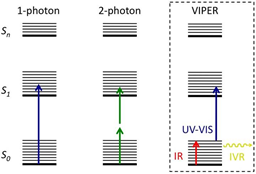

 In collaboration with the Bredenbeck group (A4)
and the Heckel group
(A2),
this PhD thesis will
systematically contribute to a cycle of theoretical prediction, spectroscopic investigation,
and synthesis, in order to optimize novel uncaging strategies. The PhD student of this project
will focus upon the Vibrationally Promoted Electronic Resonance (VIPER) experiment pioneered by
the Bredenbeck group
(A4) that potentially offers an ideal tool for orthogonal uncaging, due to
highly selective excitation in the mid-IR range, followed by a UV-Vis pulse.
In collaboration with the Bredenbeck group (A4)
and the Heckel group
(A2),
this PhD thesis will
systematically contribute to a cycle of theoretical prediction, spectroscopic investigation,
and synthesis, in order to optimize novel uncaging strategies. The PhD student of this project
will focus upon the Vibrationally Promoted Electronic Resonance (VIPER) experiment pioneered by
the Bredenbeck group
(A4) that potentially offers an ideal tool for orthogonal uncaging, due to
highly selective excitation in the mid-IR range, followed by a UV-Vis pulse.
On the theory side, the PhD student will establish a simulation protocol for the VIPER experiment
in order to assist in its interpretation and optimisation, as well as the prediction of optimal
orthogonal cages. Several steps are involved in the analysis, including (i) the calculation of
vibronic spectra as a function of vibrational excitation in the electronic ground state, (ii)
the analysis of the influence of intramolecular vibrational redistribution (IVR) on the selectivity
of the experiment, and (iii) the full simulation of the two-dimensional 2D-IR-UV/Vis experiment.
State-of-the-art multidimensional wavepacket propagation techniques will be employed, in particular
the Multiconfiguration Time-Dependent Hartree (MCTDH) method.
The PhD student will actively interact with her/his colleagues of project
A4.1
(orthogonal uncaging
strategies based on the VIPER pulse sequence) and project
A2.1
(synthesis of novel caging groups).
At an international level, the project involves a collaboration with Prof. Fabrizio Santoro (University of Pisa).
This project will focus upon molecular dynamics simulations and Markov
State modeling, along with selected electronic structure calculations
and hybrid quantum mechanics/molecular mechanics approaches.
The objective is to develop molecular-level descriptions and kinetic
models for uncaging-induced RNA and DNA folding including the effects
of conformational flexibility of the caged structures.
Collaborations with several experimental groups within the CLiC
Research Training Group will be actively pursued.
For details, see
here.
